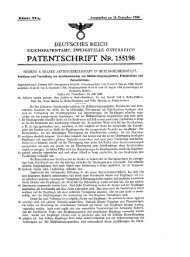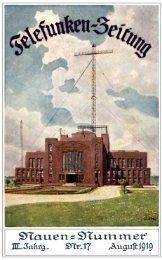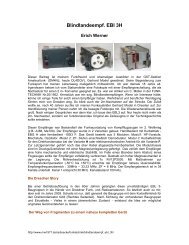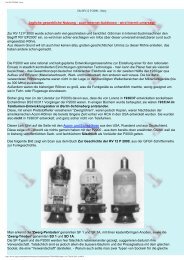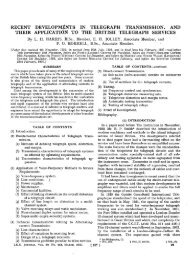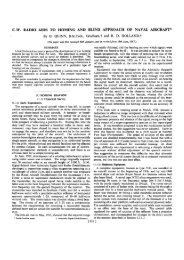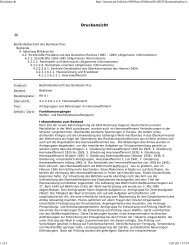- Page 1 and 2: Integrated and Modular Systems for
- Page 3 and 4: Integrated and Modular Systems for
- Page 5 and 6: Integrated and Modular Avionics •
- Page 7 and 8: Engine thrust Structure & Gear Comp
- Page 9 and 10: Why change avionics? • Airline/Op
- Page 11 and 12: Operators seek revenue enhancement
- Page 13 and 14: Why change avionics? (cont’d) •
- Page 15 and 16: Why change avionics? (cont’d) •
- Page 17 and 18: Avionics business • high-tech but
- Page 19 and 20: Changing airtransport environment 1
- Page 21 and 22: 5000 Pax-km (billions, log-scale) 1
- Page 23 and 24: Billions of 1995 US $ 80 60 40 20 9
- Page 25 and 26: 24% 23% 23% 30% 737-300 ($1834/hr)
- Page 27 and 28: Big $ numbers life-time maintenance
- Page 29 and 30: Save now and save later • increas
- Page 31 and 32: Average schedule deviation costs de
- Page 33 and 34: Integrated Modular Avionics Archite
- Page 35 and 36: Fault Avoidance - prevent (by const
- Page 37: Fault Tolerance Taxonomy Fault Tole
- Page 41 and 42: Basic ways to increase system relia
- Page 43 and 44: 1 System Reliability λunit = 5x10-
- Page 45 and 46: Note: log-log scale F (t) 2-out-of-
- Page 47 and 48: System architecture and design deci
- Page 49 and 50: 1.0 Rconfig(t) 0.9 0.8 dual Redunda
- Page 51 and 52: Simplex Dual Triplex Quad Dual-Dual
- Page 53 and 54: Integration is necessary because...
- Page 55 and 56: Integration trend: Multi-Mode Recei
- Page 57 and 58: Integration issues • “integrate
- Page 59 and 60: Fault Tolerance for Safety, Reliabi
- Page 61 and 62: Quant. Prob. 1 10-3 10-5 10-7 10-9
- Page 63 and 64: Failure System Condition Design Ass
- Page 65 and 66: Electro-Magnetic Interference (EMI)
- Page 67 and 68: Req's for Fault Avoidance (incl. Co
- Page 69 and 70: Standardization issues • “gener
- Page 71 and 72: Resources Hardware Software Standar
- Page 73 and 74: Integration & Modularization • LR
- Page 75 and 76: O/S I/O Maint. BIT Appl. Total CPU
- Page 77 and 78: Effect of integrating additional fu
- Page 79 and 80: assumes integration of related func
- Page 81 and 82: Integration & Modularization • Ot
- Page 83 and 84: German “WW II” radios • Modul
- Page 85 and 86: German “WW II” radios • Recei
- Page 87 and 88: Modular Electronics: Not a New Conc
- Page 89 and 90:
Modular Electronics: Not a New Conc
- Page 91 and 92:
IMA - Integrated Modular Avionics L
- Page 93 and 94:
IMA Level-1 • LRUs re-packaged as
- Page 95 and 96:
IMA Level-4 & -5 • Level-4: funct
- Page 97 and 98:
Major Areas of Systems Integration
- Page 99 and 100:
ATC/ATM FMS Functional Integration
- Page 101 and 102:
ATC/ATM FMS Functional Integration
- Page 103 and 104:
Integrated Flight & Thrust Control
- Page 105 and 106:
Modular Flight Control & Guidance C
- Page 107 and 108:
Modular Flight Control & Guidance C
- Page 109 and 110:
Modular Flight Control & Guidance C
- Page 111 and 112:
Modular Flight Control & Guidance C
- Page 113 and 114:
FCGC redundancy management - exampl
- Page 115 and 116:
FCGC redundancy management - exampl
- Page 117 and 118:
lliedSignal A E R O S P A C E Allie
- Page 119 and 120:
lliedSignal A E R O S P A C E Berie
- Page 121 and 122:
lliedSignal A E R O S P A C E Kiev
- Page 123 and 124:
AlliedSignal h/w AlliedSignal h/w +
- Page 125 and 126:
lliedSignal A E R O S P A C E ARIA-
- Page 127 and 128:
minus database flash memory minus D
- Page 129 and 130:
lliedSignal A E R O S P A C E Two I
- Page 131 and 132:
lliedSignal A E R O S P A C E ARIA-
- Page 133 and 134:
lliedSignal A E R O S P A C E ARIA-
- Page 135 and 136:
lliedSignal A E R O S P A C E Allie
- Page 137 and 138:
lliedSignal A E R O S P A C E Hazar
- Page 139 and 140:
lliedSignal A E R O S P A C E Hazar
- Page 141 and 142:
lliedSignal A E R O S P A C E 12,00
- Page 143 and 144:
lliedSignal A E R O S P A C E Allie
- Page 145 and 146:
lliedSignal A E R O S P A C E 20 15
- Page 147 and 148:
lliedSignal A E R O S P A C E CFIT
- Page 149 and 150:
lliedSignal A E R O S P A C E Terra
- Page 151 and 152:
lliedSignal A E R O S P A C E ref.:
- Page 153 and 154:
lliedSignal A E R O S P A C E Pink:
- Page 155 and 156:
lliedSignal A E R O S P A C E ≤
- Page 157 and 158:
lliedSignal A E R O S P A C E IHAS:
- Page 159 and 160:
lliedSignal A E R O S P A C E Stick
- Page 161 and 162:
lliedSignal A E R O S P A C E Advan
- Page 163 and 164:
lliedSignal A E R O S P A C E $ $$
- Page 165 and 166:
lliedSignal A E R O S P A C E a/c d
- Page 167 and 168:
lliedSignal A E R O S P A C E IHAS
- Page 169 and 170:
lliedSignal A E R O S P A C E Parti
- Page 171 and 172:
lliedSignal A E R O S P A C E Proce
- Page 173 and 174:
lliedSignal A E R O S P A C E Proce
- Page 175 and 176:
lliedSignal A E R O S P A C E Backp
- Page 177 and 178:
lliedSignal A E R O S P A C E sets
- Page 179 and 180:
lliedSignal A E R O S P A C E Growt
- Page 181 and 182:
lliedSignal A E R O S P A C E Fligh
- Page 183 and 184:
lliedSignal A E R O S P A C E Unifi
- Page 185 and 186:
lliedSignal A E R O S P A C E Allie
- Page 187 and 188:
lliedSignal A E R O S P A C E Typic
- Page 189 and 190:
lliedSignal A E R O S P A C E Integ
- Page 191 and 192:
lliedSignal A E R O S P A C E - Com
- Page 193 and 194:
Related utilities sub-systems that
- Page 195 and 196:
A/C Loads lliedSignal A E R O S P A
- Page 197 and 198:
lliedSignal A E R O S P A C E Integ
- Page 199 and 200:
lliedSignal A E R O S P A C E MAFT/
- Page 201 and 202:
lliedSignal A E R O S P A C E Globa
- Page 203 and 204:
from all other nodes + wrap from ow
- Page 205 and 206:
lliedSignal A E R O S P A C E RTEM
- Page 207 and 208:
lliedSignal A E R O S P A C E MAFT/
- Page 209 and 210:
1 Integrated and Modular Avionics
- Page 211 and 212:
3 FANS: Future Air Navigation Syste
- Page 213 and 214:
5 Component and System Performance
- Page 215 and 216:
7 Component and System Performance
- Page 217 and 218:
9 Future ........ (cont’d) • im
- Page 219 and 220:
11 150 k ↑ Total airplane signal
- Page 221 and 222:
13 100 MB 80 MB 20 MB 10 MB 747-200
- Page 223 and 224:
15 System Complexity and Size Typic
- Page 225 and 226:
17 Given: Extrapolation ...... •
- Page 227 and 228:
19 Enabling technologies - componen
- Page 229 and 230:
Enabling technologies - drivers for
- Page 231 and 232:
23 Enabling technologies - design /
- Page 233 and 234:
25 236-pin connector Example: PC mo
- Page 235 and 236:
27 Example: integrated X-band power
- Page 237 and 238:
29 Cold-Cathode Field Emission Disp
- Page 239 and 240:
31 Enabling technologies - componen
- Page 241 and 242:
33 Resource Partitioning - part of
- Page 243 and 244:
35 Enabling technologies - communic
- Page 245 and 246:
37 High Medium Low Enabling technol
- Page 247 and 248:
39 Enabling technologies � s/w
- Page 249 and 250:
1 BOOKS BIBLIOGRAPHY F.J. Redmill (
- Page 251 and 252:
3 M.L. Shooman: "A study of occurre



